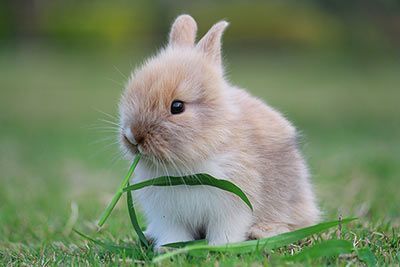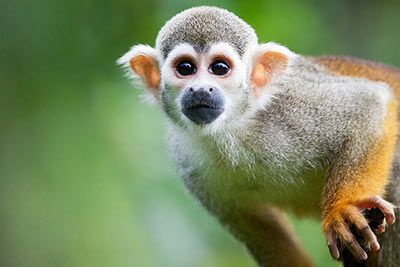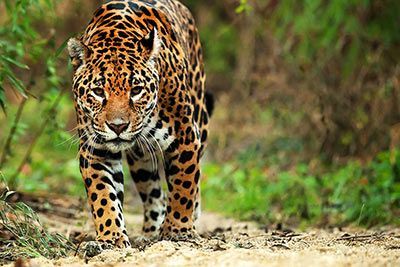Hippopotamus
Hippopotamus Facts
| Size | 51-64 inches (130-165 cm) (shoulder height) |
| Speed | 18-25 mph (30-40 km/h) (short distances) |
| Weight | 2,866-3,306 pounds (1,300-1,500 kg) |
| Lifespan | 40-50 years |
| Food | Water plants, grass |
| Predators | Lions, crocodiles |
| Distribution | Africa |
| Habitat | Grassland, rivers, lakes, mud holes |
| Order | Even-toed ungulates |
| Family | Hippopotamus |
| Scientific name | Hippopotamus amphibius |
| Characteristics | Large, heavy ungulate with long canine teeth |
Main Characteristics
Hippos are very large and heavy herbivores that live near water. They are the third heaviest land animals after the elephant and the rhinoceros. Their most striking features are their large mouth, their long, tusk-like canines, their cylindrical body and their short legs. The animals are considered aggressive and dangerous.

Species
There are two species: the large hippopotamus (Hippopotamus amphibius) and the half-sized, lesser-known pygmy hippopotamus (Hexaprotodon liberiensis).
Closest Relatives
Hippos look similar to pigs because they have smooth skin and large tusks. However, these are not their closest relatives. In fact, they're most closely related to whales and dolphins. The species began to evolve separately around 55 million years ago.
Distribution and Habitat
Hippos live in Africa. The large hippopotamus lives in lakes, slow-moving rivers and grasslands. The pygmy hippopotamus has a slightly different habitat. It prefers rainforests and swamps. Because it is smaller, it gets through the thickets of the rainforest easily and, because it is lighter, it doesn't sink as much into the swampy ground.
Life Style
Hippos live in small social groups consisting of females, juveniles and one male. They are active at dusk and at night. This means that they are particularly active when it is dark and rest during the day. They spend about 16 hours a day in the water. Most of the time only their ears, eyes and nostrils stick out of the water. They only come to land to eat plants. Pygmy hippos tend to live more solitary lives.

Anatomy and Appearance
Size and Weight
Hippos are the largest and heaviest mammals that live primarily in freshwater. They reach a shoulder height of 51-64 inches (130-165 cm). Their body length is 102-137 inches (260-350 cm). They weigh 2,866-3,306 pounds (1,300-1,500 kg). The females are slightly smaller and lighter. The heaviest hippo was a bull weighing 5,860 pounds (2,660 kg). A higher weight is unlikely, but you can still come across online sources claiming there was an individual that weighed 9,920 pounds (4,500 kg). Conversion errors between pounds and kilograms could be the reason.
Teeth
Hippos have long canine teeth in their upper and lower jaws. In the upper jaw they can be up to 12 inches (30 cm) long. In the lower jaw even up to 20 inches (50 cm). According to the Guinness Book of Records, they can even reach a length of 28 inches (71 cm) and the longest hippo tooth was 48 inches (122 cm) long.
Mouth
The hippopotamus has the largest mouth opening of any mammal in the world. By folding its lower jaw down, it reaches an impressive angle of 150-180° and a mouth span of 35-47 inches (90-120 cm) in width. Humans, on the other hand, are limited to reaching a maximum angle of 45°.
Hooves
Hippos are even-toed ungulates. Even though you can't usually see their hooves very well, they have four toes. The toes are webbed to make it easier to move forward in the water.
Skin
The skin of hippos is about 2 inches (6 cm) thick.Hippos' skin looks very smooth. But if you look closer, you can see that she is very wrinkled. Almost no hair grows on it.
Sweating blood
Hippos have many small glands in their skin from which a red fluid comes out. It used to be believed that the animals “sweated blood”. But it is neither blood nor sweat. When the liquid comes out, it is transparent at first. After a few minutes it turns red to brown. It protects the animals from drying out and sunburn. It also prevents bacteria from spreading on the skin.

Diet
Hippos eat 88 pounds (40 kg) of grass every day. At night, they leave the water and go on land to find places where there is lots of lush grass. They spend about six hours there before returning to the water. Even though they eat so much grass, they are not good at chewing their food. The large incisors restrict grinding movements of the lower jaw. It can move vertical but not side-to-side. Due to this, hippos are unable to chew and grind. They just mash the grass a bit before swallowing it.
Behavior
Why Do Hippos Have Long Teeth?
Their long canines may seem impractical, but they actually serve a purpose. Contrary to popular belief, these teeth are not used for eating, but rather for defending themselves and engaging in fights with their rivals.
Why Do Hippos Open Their Mouths so Wide?
The purpose of a hippo displaying its open mouth is to create a threatening image, either to intimidate competitors or to ward off potential harm.
Are Hippos Dangerous?
Hippos exhibit aggressive behavior, especially when their territory is invaded or when they are protecting their young. Such encounters can quickly become dangerous. They attack without hesitation. Even though they're big and heavy, they're able to run amazingly fast and easily catch up with people. They can even flip over boats. Approaching these animals without caution can result in a life-threatening attack. Tragically, every year, individuals lose their lives due to either unintentionally or recklessly getting too close to these creatures. However, the animals usually don't attack if you keep your distance.
Hippos Defend their Territory
Hippos establish and protect their own territory. They mark the boundaries with their feces. Anyone who enters the territory is an intruder, is viewed as a threat and is attacked. This applies to animals and to people.

Senses and Abilities
Swimming
It's hard to believe, but hippos are actually bad at swimming, despite spending nearly all day in the water, sometimes up to 16 hours. Luckily, they have a nifty trick to move around in the water: They descend to the bottom and simply tread across it. They move lightly, almost like dancers or like Astronauts walking on the moon.
Diving
Hippos usually only stay underwater for 30-60 seconds. But most can dive for up to 5 minutes. It is said that they are even capable of diving for up to 30 minutes. Before going under water, the animals close their ears and nostrils.
Sleeping
When it comes to sleep, hippos prefer to doze off in the water, with their nostrils positioned above the surface for easy breathing. It's fascinating to know that hippos can actually sleep underwater without having to wake up when they need to breathe. They simply raise their nostrils above the water's surface while they're still asleep.
Speed
Hippos are surprisingly fast. They can run at speeds of up to 18 mph (30 km/h). That's about as fast as a human's world record for a 400 m sprint.
Communication
Sounds
Do hippos make sounds? Yes. They use sounds to communicate with their fellow species. They even recognize each other by their voices. They also have a unique ability: they make sounds that can be heard both above and below the surface! How does it work? They produce sounds with their nose and mouth while the nose is above the surface and the mouth is below the surface. In this way they can communicate both above and below water.
Can Hippos Jump?
No. Neither do elephants and rhinos.
Bite Force
Hippos have incredibly powerful jaws. They are among the animals with the highest bite force in the world. Their bite force is 1,800 PSI (8,100 Newtons).
• Comparison
The bite force of the hippo is only beaten by the saltwater crocodile exerting 3,700 PSI (16,000 Newtons) and the great white shark exerting 4,000 PSI (18,000 Newtons). The average bite force of humans is measured at 120-160 PSI (280-300 Newtons).
• Units of Measurement
PSI is the abbreviation for “pound-force per square inch”. Newton is the unit of force combined with weight and speed. Both units of measurement can indicate the bite force of an animal.

Life Expectancy
In the wild, hippos live to be 30-40 years old. The oldest hippo in the world was called Bertha and lived to be 65 years old. It lived in a zoo in the Philippines. “Lu the Hippo” is currently the oldest living hippo. He turned 64 in January 2024 and lives in a game reserve in Florida.
Enemies and Threats
Natural Enemies
Adult hippos have no natural enemies. In rare cases, lions or crocodiles can snatch an unguarded cub.
Humans
The greatest threat for hippos are people. Because of us, hippos are losing more and more habitat. They're also hunted because they're aggressive and people are afraid of being hurt by them. Their meat fetches high prices on the black market. Likewise their tusks. They are used as an alternative to elephant tusks.
Population Numbers
The IUCN published in 2016 that there are around 115,000-130,000 hippos still alive. Nevertheless, the species is considered “vulnerable”. As for the pygmy hippo, according to a 2015 IUCN report, there are still around 2,000-2,500 animals left (as of February 2024, no more recent data available). It is considered “endangered”.
Importance for the Ecosystem
With their heavy weight and massive body, hippos create small ditches and water holes. These natural formations serve as habitats and offer protection for smaller animals. Additionally, the droppings of hippos contribute to fertilizing the soil.

Reproduction
Hippos mate in water. After a gestation period of 227-240 days a single calf is born. At birth it already weighs 44-110 pounds (25-50 kg). Baby hippos can swim right from the start, because they are born and even suckle under water. The mothers are very caring. They let their baby ride on their back as they wade through deeper waters. When a predator approaches, they fiercely protect their young with all their strength.
Evolution and History
Hippos on the Rhine
Who would have thought: hippos lived in the river Rhine over 30,000 years ago. It was bitterly cold back then because it was an ice age. Nevertheless, the animals were able to adapt to the temperatures.
Name
Hippos were first discovered on the banks of the river Nile. This is why the animals are still called „Nilpferd“ (Nil + Pferd = Nile + Horse) in German. However, the term is outdated and the animals no longer live on the Nile.
What Does Hippopotamus Mean?
The name derives from the Greek word "hippopótamos" and means "water horse" (hippo = horse; potamós = water). The scientific term is often abbreviated as "hippo".

Fun Facts
Why Do Hippos Have Long, Thin Tails?
If hippos have to defecate, they rotate their tail like a propeller and spread their feces everywhere. This is how they mark their territory.
Egyptian Goddess
The ancient Egyptians worshiped a goddess who looked like a hippo. Her name was Taweret. She was the patron goddess of pregnant women.
Hippodrome
In ancient times, a horse racing track was called a hippodrome.
The Hippopotamus Is Related To:
Animals in the Same Biome:
- Find Out More:
- Animals That Sleep the Most
- Watch Now on animalfunfacts.net:
 All About Mammals
All About Mammals Why Do Animals Live in Groups?
Why Do Animals Live in Groups? The Strongest Animals in the World
The Strongest Animals in the World




















